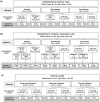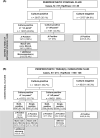The role of BioFire Joint Infection Panel in diagnosing periprosthetic hip and knee joint infections in patients with unclear conventional microbiological results
- PMID: 38981611
- PMCID: PMC11233181
- DOI: 10.1302/2046-3758.137.BJR-2023-0321.R2
The role of BioFire Joint Infection Panel in diagnosing periprosthetic hip and knee joint infections in patients with unclear conventional microbiological results
Abstract
Aims: This study aimed to evaluate the BioFire Joint Infection (JI) Panel in cases of hip and knee periprosthetic joint infection (PJI) where conventional microbiology is unclear, and to assess its role as a complementary intraoperative diagnostic tool.
Methods: Five groups representing common microbiological scenarios in hip and knee revision arthroplasty were selected from our arthroplasty registry, prospectively maintained PJI databases, and biobank: 1) unexpected-negative cultures (UNCs), 2) unexpected-positive cultures (UPCs), 3) single-positive intraoperative cultures (SPCs), and 4) clearly septic and 5) aseptic cases. In total, 268 archived synovial fluid samples from 195 patients who underwent acute/chronic revision total hip or knee arthroplasty were included. Cases were classified according to the International Consensus Meeting 2018 criteria. JI panel evaluation of synovial fluid was performed, and the results were compared with cultures.
Results: The JI panel detected microorganisms in 7/48 (14.5%) and 15/67 (22.4%) cases related to UNCs and SPCs, respectively, but not in cases of UPCs. The correlation between JI panel detection and infection classification criteria for early/late acute and chronic PJI was 46.6%, 73%, and 40%, respectively. Overall, the JI panel identified 12.6% additional microorganisms and three new species. The JI panel pathogen identification showed a sensitivity and specificity of 41.4% (95% confidence interval (CI) 33.7 to 49.5) and 91.1% (95% CI 84.7 to 94.9), respectively. In total, 19/195 (9.7%) could have been managed differently and more accurately upon JI panel evaluation.
Conclusion: Despite its microbial limitation, JI panel demonstrated clinical usefulness by complementing the traditional methods based on multiple cultures, particularly in PJI with unclear microbiological results.
© 2024 Gardete-Hartmann et al.
Conflict of interest statement
S. Gardete Hartmann reports financial support from BioFire Diagnostics, bioMérieux for attendance with oral presentation and poster presentation at 40th Annual Meeting of the European Bone and Joint Infection Society (EBJIS), and the Interdisciplinary Course on Antibiotics and Resistance (ICARe) 2022, respectively. J. G. Hofstaetter and S. Gardete Hartmann report payment for expert testimonial by BioFire Diagnostics, bioMérieux, unrelated to this study. The remaining co-authors report no conflict of interest.
Figures


Similar articles
-
Comparison of the BioFire Joint Infection Panel to 16S Ribosomal RNA Gene-Based Targeted Metagenomic Sequencing for Testing Synovial Fluid from Patients with Knee Arthroplasty Failure.J Clin Microbiol. 2022 Dec 21;60(12):e0112622. doi: 10.1128/jcm.01126-22. Epub 2022 Nov 21. J Clin Microbiol. 2022. PMID: 36409108 Free PMC article.
-
First evaluation of a commercial multiplex PCR panel for rapid detection of pathogens associated with acute joint infections.J Bone Jt Infect. 2023 Jan 18;8(1):45-50. doi: 10.5194/jbji-8-45-2023. eCollection 2023. J Bone Jt Infect. 2023. PMID: 36756306 Free PMC article.
-
Alpha-defensin as a diagnostic tool in revision total knee arthroplasties with unexpected positive intraoperative cultures and unexpected culture negative intraoperative cultures.Knee Surg Sports Traumatol Arthrosc. 2023 Apr;31(4):1462-1469. doi: 10.1007/s00167-022-07268-w. Epub 2022 Dec 12. Knee Surg Sports Traumatol Arthrosc. 2023. PMID: 36509937
-
The Role of Single Positive Cultures in Presumed Aseptic Total Hip and Knee Revision Surgery-A Systematic Review of the Literature.Diagnostics (Basel). 2023 May 8;13(9):1655. doi: 10.3390/diagnostics13091655. Diagnostics (Basel). 2023. PMID: 37175046 Free PMC article. Review.
-
Sonication of Arthroplasty Implants Improves Accuracy of Periprosthetic Joint Infection Cultures.Clin Orthop Relat Res. 2017 Jul;475(7):1827-1836. doi: 10.1007/s11999-017-5315-8. Clin Orthop Relat Res. 2017. PMID: 28290115 Free PMC article. Review.
Cited by
-
Diagnosis and Treatment of Acute Periprosthetic Infections with the BioFire® System within a Time-Dependent and Bacterium-Dependent Protocol: Review and Prosthesis-Saving Protocol.Biomedicines. 2024 Sep 12;12(9):2082. doi: 10.3390/biomedicines12092082. Biomedicines. 2024. PMID: 39335595 Free PMC article. Review.
-
Clinical performance evaluation of the BioFire Joint Infection Panel.J Clin Microbiol. 2024 Nov 13;62(11):e0102224. doi: 10.1128/jcm.01022-24. Epub 2024 Oct 9. J Clin Microbiol. 2024. PMID: 39382308
References
-
- Alazzawi S, Khan O, Haddad FS. Periprosthetic infection in the hip joint. Management of Periprosthetic Joint Infections (PJIs) 2017:119–132.

